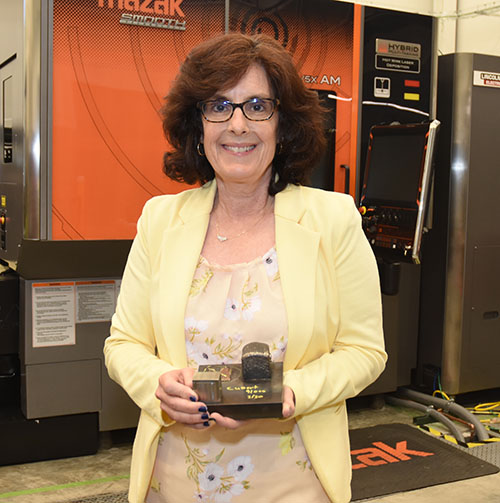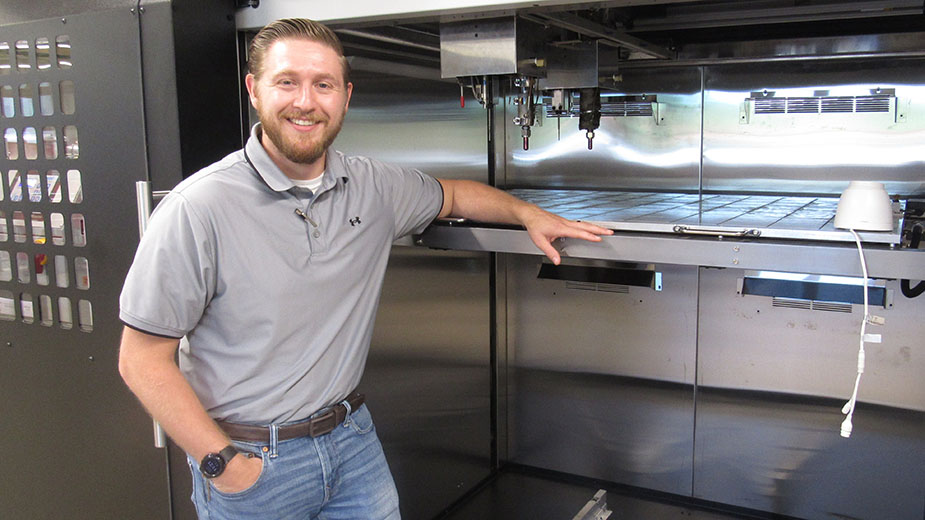YOUNGSTOWN, Ohio – For years, JuggerBot 3D in Youngstown tried to win grants through the Department of Defense so it could demonstrate new technologies related to additive manufacturing, says its president, Zac DiVencenzo.
With no success.
“It’s hard,” DiVencenzo says. “It’s very hard. There are so many other companies applying.”
Then in 2020, the company, along with academic partner Penn State University Behrend, submitted another proposal for the U.S. Army through the government Small Business Technology Transfer, or STTR, program. The project called for developing a process to 3D print a product using two different materials, such as silicone and epoxy.
“We won,” he recalls. “It was a six-month project worth $166,000.”
JuggerBot 3D then produced demonstration versions of various seals manufactured with two separate materials from a single 3D printer. Unfortunately, the company was denied a second round of funding.
DiVencenzo considered it a learning experience that has positioned his business – a portfolio company in the Youngstown Business Incubator with fewer than 15 employees – to pursue other opportunities with the defense industry. JuggerBot 3D manufactures medium and large-scale 3D printers.
This year, the company is considering applying for direct Phase II Small Business Innovation Research, or SBIR, funding through the Department of Defense for another project.
Generally, an SBIR Phase II would draw between $750,000 and $1.2 million in funding, he says.
It’s an example of how small companies in the Mahoning Valley have caught the attention of big customers such as the Department of Defense. Businesses here have supplied the military with everything from packaged foods to fire safety-training services. Moreover, the defense industry has become more aware of the technological capabilities of firms that today are reimagining advanced manufacturing.
BIG OPPORTUNITIES FOR SMALL COMPANIES
Our primary customer is the Department of Defense,” says Lenna Boggs, proposal coordinator at Kirila Fire Training Inc. in Hartford Township. The company trains military personnel on how to respond to fire emergencies on aircraft and vehicles. Kirila also fabricates mock aircraft, towers and vehicles that are ignited through a patented system the company created and uses for training.
Boggs says approximately 90% of Kirila’s business is with the Department of Defense. “It’s pretty steady and we’re pretty full,” she says. Two mobile units approximately the size of a charter bus enable the company to visit military installations throughout the country, and in some cases, in foreign countries.
Boggs has dealt with government contracts for 20 years, and says there’s more opportunity today for small businesses to become engaged with government. “There are so many avenues and resources to get started,” she says.
Others that engage in traditional business have also found great success with the Department of Defense.
“The qualification process is rigid but once you master the process, the DOD has many opportunities,” says Dawn Ochman, president of Dawn Inc., a general contractor based in Warren. Approximately 70% of Dawn Inc.’s business is through the Department of Defense. These projects range from standard renovation jobs to ones the military considers top secret.
“Many projects are high security and classified,” she says. “Others can be a simple office renovation.”
Dawn Inc. has worked on taxiways at air installations, training centers, boiler and mechanical upgrades, restaurant and kitchen installations, chiller installations and hangar repairs, Ochman says.
Often, the projects are very similar to Dawn Inc.’s standard commercial and industrial work, she says.
Small companies ranging from manufacturers to catering services have all done work with the Department of Defense, according to GovernmentContractsWon.com. The result is hundreds of millions of dollars in business to area companies.
ECONOMIC IMPACT HERE
Indeed, the defense industry has a strong spending presence in the Mahoning and Shenango valleys. According to USA.Spending.gov, a website that tracks government contracts and allocations, the Department of Defense has awarded $333.6 million in business to companies in Mahoning, Trumbull and Columbiana counties since fiscal year 2018.
In Mahoning County, more than $112.7 million worth of prime and subcontracts were let over the past five years to companies here. Firms in Trumbull County doing business with Defense received $84.3 million in both prime and subcontract awards since 2018, while companies in Columbiana County won $126.6 million worth of business.
In Lawrence and Mercer counties in western Pennsylvania, Defense awarded $96.4 million in contracts between 2018 and 2022. Companies in Lawrence County claimed $62.3 million from the Department of Defense, while those in Mercer County secured $34.1 million in DOD business.
Statewide, military spending continues to be robust. In 2020, defense spending exceeded $22.2 billion, according to a recent study compiled by JobsOhio. Approximately 35% of this spending went to veterans and retirees, another 35% to procurement contracts, and 30% toward payroll for National Guardsmen, active duty personnel, government civilian workers, and reservists stationed across the state, the study shows.
In northeastern Ohio, military spending represents 5% of the area’s gross regional product but supports 108,500 jobs – more jobs than any other region in the state. The area is dominated by operations such as the NASA Glenn Research Center in Cuyahoga County, the Youngstown Air Reserve Station in Trumbull County, and Camp Garfield in Portage County.
In 2020, the military spent more than $5.5 billion in the region. Approximately half of this spending was directed toward pensions and transfers for veterans, another 30% came as civilian and military payroll, while 20% of this went to secure procurement contracts.
The majority of procurement contracts across the state – approximately 55% – are concentrated in two industries, the report noted. Some 35% of these contracts are related to aerospace products and parts manufacturing, while 20% are devoted to scientific research and development services.
INNOVATION AND ADVANCED MANUFACTURING
The Mahoning Valley has emerged as a major center for both research and advanced manufacturing efforts to support military programs in the country. Youngstown-based America Makes, the nation’s first advanced manufacturing hub formed in 2012 for the Obama Administration’s Manufacturing USA network, has enabled local companies to partner with major defense contractors such as Lockheed Martin and Raytheon on complex defense projects.
“A lot of this innovation is because of America Makes,” says Charles George, president of Hapco Inc., and chief financial officer of Big Metal Additive, based in Colorado. George is also president of Strangpresse, a portfolio company of the Youngstown Business Incubator that designs and manufactures extrusion heads for large 3D printers.
George says Hapco and Big Metal Additive are engaged in two projects with the Department of Defense. One product that Hapco supplies to the military is a heat tool used to shrink and retool the fiber on the F-25 Pacific Eagle and F-22 Raptor fighter jets.
The second involves a more sensitive project with the DOD related to Big Area Additive Manufacturing, or BAAM, George says. “It’s some pretty cool stuff. But there’s nothing I can really say about it,” he says.
What has changed over the last decade or so is the willingness of the defense industry to expand its efforts to engage small and medium-size companies in larger projects, George says. “Ironically, the breakthroughs usually come from these small and medium-size businesses,” he says.
The presence of America Makes in Youngstown has made a significant impact on those companies participating in DOD programs, says Rich Lonardo, a consultant and retired U.S. Army technology specialist based in the region.
“Over the last 10 years, America Makes has brought in millions of dollars in funding,” Lonardo says. “At least $20 million has poured through these programs.”
Michael Garvey, president of Center Street Technologies Inc., Youngstown, says working with major customers such as the Department of Defense stimulates innovation. Garvey’s company is working with the Air Force Research Laboratory to develop additive manufacturing technology that could be used for a variety of products.
In October 2020, U.S. Rep. Tim Ryan, D-13 Ohio, helped to secure $9.4 million in funding for Center Street and the National Center for Defense Manufacturing and Machining for the project. Ryan serves as vice chairman of the U.S. House Committee on Appropriations’ subcommittee on defense and
is the Democratic nominee for the U.S. Senate this fall.
“We’ve got 15 qualified engineers on staff from undergraduate to Ph.Ds,” Garvey says. “We’re convinced that what we’re doing will not only apply to defense, but also commercial applications. We’re creating a company that will have a significant amount of jobs for generations.”
Center Street houses one of the world’s largest 3D printers, one big enough to park a full-size SUV in it with ample room to spare.

The Mahoning Valley’s success in pursuing advanced manufacturing contracts with Defense is critically dependent on strong partnerships with academia, workforce and economic development agencies and the private sector, specialists say.
Also integral to strengthening ties between the private sector and the defense community is Youngstown State University and the Procurement Technical Assistance Center, or PTAC, in the Ohio Small Business Development Center at YSU.
Jackie Ruller, director of the YSU Excellence Training Center, says it is engaged in two projects with the Department of Defense.
In May, a consortium composed of YSU, the University of Northern Iowa and the National Center for Defense Manufacturing and Machining (the administrative arm of America Makes), was awarded $10 million in support of the Defense Logistics Agency. The goal is to educate businesses on adopting advanced technologies such as robotics, artificial intelligence and 3D printing.
The program is especially directed to foundries that could benefit from these improvements, Ruller says. Among the goals of the program is to prepare these companies to manufacture components for the defense industry at a rapid pace, thus alleviating any supply-chain problems, she says.
YSU’s training center also received a $2.3 million research grant from the Air Force Research Laboratory to buy a Mazak hybrid system that incorporates both additive and traditional manufacturing.
“The research is to figure out its capabilities and to see if it can repair metal molds and dies instead of replacing them,” she says.
Rich Delisio, PTAC director, says his organization helps to introduce companies to the government’s procurement program, providing information on SBIR and STTR funding. The YSU Excellence Training Center, he says, is an invaluable resource where companies can develop prototypes or hone their work in preparation for a government contract.
“I’d like to see the ETC have a type of SBIR laboratory,” Delisio says. “They’re doing a lot of neat stuff.”
Research and technology transfer grants are integral for those smaller companies looking to participate in defense programs, says Rick Stockburger, CEO of Brite Energy Innovators in Warren.
“SBIR and STTR funding is really important since it’s nondiluted capital,” he says. That means the Department of Defense is not requiring an equity stake in the company, whereas financing through a venture capital firm would.
“It’s important for early-stage companies working with us, the Youngstown Business Incubator and America Makes,” Stockburger says.
Among the companies working with Brite that have won DOD funding are PetraPower, a solid oxide fuel cell company; PCKA, which has developed ambient cooling film for buildings; and NecoTech, a Columbus-based company that recycles waste into building materials, such as hot patch for roads.
“We’ve done 20 or 30 SBIRs across the state,” Stockburger says. Moreover, all of these projects have a future for civilian use. “It’s exciting to see technologies that can fulfill the national mission in defense, as well as a commercial vision in selling their products.”
Pictured at top: Zac DiVencenzo, president of JuggerBot 3D, stands with one of the company’s latest 3D printers.
